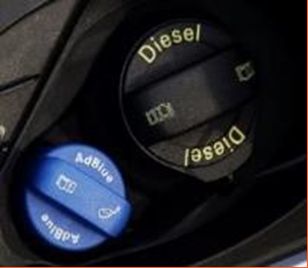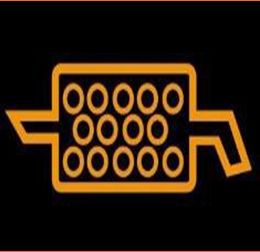AdBlue or diesel exhaust fluid (DEF)
This is an aqueous urea-based solution stored in a dedicated tank and injected into the exhaust stream of a diesel engine to lower harmful emissions.
This content is for general information only. It does not, and is not intended to, provide legal or technical advice or to represent a legal interpretation of the matters it addresses.Frequently asked questions
This is an aqueous urea-based solution stored in a dedicated tank and injected into the exhaust stream of a diesel engine to lower harmful emissions.
Diesel engines are now required to meet strict Nitrogen Oxide (NOx) emission standards to help control air pollution. AdBlue assists in lowering the release of harmful emissions into the environment.
It is injected into the selective catalytic reduction (SCR) catalyst setting off a chemical reaction in order to convert the NOx into nitrogen, water and tiny amounts of carbon dioxide (CO2).
Neither. It has its own tank and is stored completely separately to the fuel. It is an exhaust additive and NEVER goes into engine.
Most diesel cars registered new after late 2015 will use AdBlue
To check if your car uses AdBlue:
- refer to the owner’s manual or contact the manufacturer or authorised distributor.
- look for an AdBlue filler cap next to the fuel filler (as shown), the boot or under the bonnet.
- check the use of ‘Blue’ or SCR in the model's name.

Most new vehicles will have a dashboard warning light which notifies you if there is a particular error or if you are running low in oils or fluids including AdBlue. Every vehicle is different so refer to owner’s manual or contact the manufacturer or authorised distributor.
If AdBlue runs dry a warning signal will light up on dashboard showing ‘Refill AdBlue’. You will need to add AdBlue, or the engine will not restart once you stop it.
This will depend on the type of vehicle:
- For cars, a standard 10 litre pack will be sufficient to refill the tank to a comfortable level.
- Larger vehicles e.g., large trucks and buses will require several packs or a larger volume from a barrel such as an intermediate bulk container (IBC) or AdBlue dispensing system.
You can also refer to owner’s manual or contact the original manufacturer.
Yes. Many service stations display the AdBlue symbol. You can refer to your owner’s manual or contact the vehicle manufacturer for advice on the recommended fluid to use. Always follow manufacturer’s guidelines for usage of product when refilling your tank.
Do not start the vehicle. The tank will need to be drained. If there is any lasting damage, contact the manufacturer.
Refer to owner’s manual or contact the manufacturer. It is recommended that you should only buy a product bearing the name AdBlue and that it is manufactured according to the applicable ISO standards.
A device used to disable exhaust-cleaning systems such as AdBlue.
Yes. Under road traffic regulations, it is an offence to use a vehicle in a public place that has been modified to an extent that it no longer complies with the air pollutant emissions standards that it was originally designed to meet. Enforcement of this legislation is the responsibility of An Garda Síochána.
Diesel particulate filters (DPF)
This is a filter which is placed in the exhaust system of a diesel vehicle to remove particulate matter or trap soot from exhaust gases. It helps reduce harmful emissions released into the atmosphere and assists Ireland in meeting European emission standards.
Frequently asked questions
This is a filter which is placed in the exhaust system of a diesel vehicle to remove particulate matter or trap soot from exhaust gases in the case of diesel engines. It helps reduce harmful emissions released into the atmosphere and assists Ireland in meeting European emission standards.
If the DPF becomes clogged with soot or a fault develops in the system an orange light will typically appear on the dashboard as shown. Other signs can include a reduction in power or reduced fuel economy. For further information check your owner’s manual or contact the original manufacturer.

Short journeys at low speeds and poorly serviced cars are some of the causes. A long drive can assist in clearing out the DPF and it is also important to use the correct fuel as some diesels contain additives that can actually block filters.
This is a mixture of small solid and liquid particles that are suspended in air including carbon, ammonium, sulphate, mineral dust, and water. It can be produced either directly as a consequence of a certain activity e.g., an engine, or from reactions between other pollutants in the atmosphere.
DPF’s need to be emptied of trapped particulate matter on a regular basis which involves burning the soot present at a very high temperature leaving behind only a very small residue of matter. Sometimes when you turn your diesel engine off you can hear a fan running. This is the regeneration sound.
Yes. Under S.I. No. 190 of 1963 of Road Traffic Construction, Equipment and Use Regulations 1963 (as amended), it is an offence to use a vehicle that has been modified in such a way that it emits any harmful content that may cause damage to person or property or endanger the safety or health of any other user of the public place. Removal of a DPF will almost invariably contravene these requirements making the vehicle illegal for road use thus potentially resulting in penalties. The enforcement of road traffic legislation is a matter for An Garda Síochána.
By removing a DPF you are allowing harmful cancer-causing toxic emissions to be released into the environment. Diesel vehicles are more fuel efficient and so are cheaper to run but they also produce more pollution. Therefore environmental protection features such as DPFs and diesel exhaust fluid systems or AdBlue are required to help reduce the amount of dangerous emissions entering the atmosphere.
The manufacturer or authorised distributor is normally responsible for the calibration of the smoke meters in Ireland. The agent does not have to be independently accredited. The calibration intervals for smoke meters used for passenger cars at NCT are every 6 months and for commercial vehicles (CVRT) every 12 months.
Information and regulations for important vehicle components including lights, seat belts, glass and tyres.